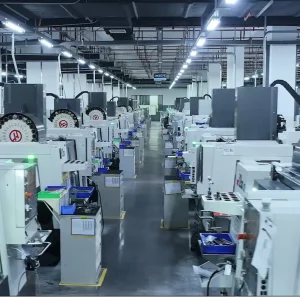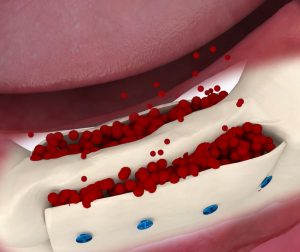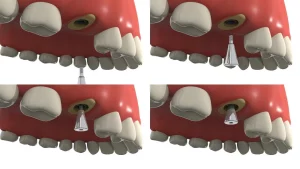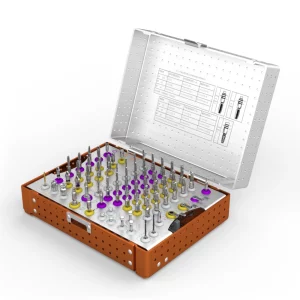In the realm of oral medicine, dental implants have been used extensively as a contemporary technique for tooth replacement. In order to restore function and appearance, an artificial implant is inserted into the location of the lost tooth and closely integrates with the surrounding bone tissue. The main component of a dental implant is the implant, sometimes referred to as the prosthetic tooth root. It is usually composed of materials like titanium alloy that are highly biocompatible. These materials provide a strong basis for ensuing repairs since they can sustain chewing pressures for extended periods of time without suffering damage.
The implant abutment is an essential component of a dental implant system. The crucial element that joins the implant (fake tooth root) to the top restoration (like a crown) is the implant abutment. It ensures a solid link between the implant and the upper portion by supporting and stabilising the restoration while sitting between the implant and the crown. Chewing function is restored when the biting forces are transmitted from the crown to the implant and then dispersed into the alveolar bone via the abutment.
One of the most important parts of the dental implant system is the implant abutment, which connects and supports the restoration. The implant abutment provides patients with improved oral rehabilitation by selecting the right material and carrying out accurate design, which guarantees the stability and effectiveness of the dental restoration.
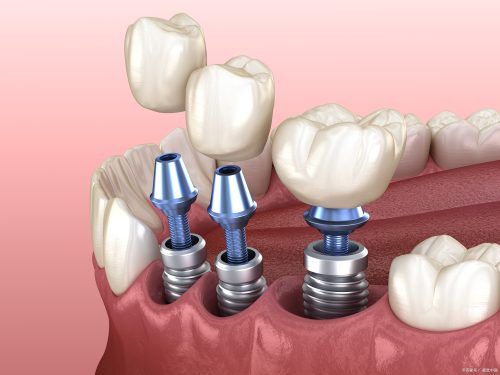
Definition of Dental Implant Abutment
The dental implant abutment, as a core component in dental implant restoration, plays the role of a bridge between the implant and the artificial tooth (i.e., dental crown). It is strategically placed between the implant—an artificial structure that is deeply embedded into the alveolar bone to mimic a natural tooth root—and the crown above, forming a stable and precise connection system. The abutment’s presence ensures a stable connection between the implant and the restoration (such as a well-crafted dental crown) and, through its precise design, facilitates the effective transmission and distribution of forces, ensuring the overall stability and durability of the dental implant. The design of this intermediate component reflects the sophistication of oral medical technology and demonstrates a deep understanding and fulfillment of the patient’s needs for oral health and aesthetics. Therefore, the dental implant abutment is not only a technical necessity but also a key to the successful restoration of the dental implant, helping to restore the patient’s chewing function and oral aesthetics.
Components of the Dental Implant Abutment
As a key component in dental implant restoration, the components and features of the dental implant abutment are crucial to the success of the dental implant. The following is a detailed description of the components of the dental implant abutment:
1. Connection Part
The connection part of the dental implant abutment refers to how the abutment is connected to the implant. Common connection methods include:
- Screw-fixed Connection: This method involves screwing the screw on the abutment into the implant’s threaded hole to achieve a tight connection. It is one of the most commonly used methods in clinical practice due to its secure fixation, ease of disassembly, and cleaning.
- Press-fit Connection: This method involves pressing the abutment directly into the implant’s pre-made hole, using the friction and fit between the abutment and the implant for connection. While the procedure is relatively simple, it may not be as convenient for disassembly and cleaning compared to the screw-fixed method.
2. Shape Design
The shape design of the dental implant abutment varies to accommodate different patients’ oral anatomy and restoration needs. Common design types include:
- Standard Abutment: The standard abutment has a universal design and size that suits most patients’ oral conditions. Its simple structure and relatively low production cost make it one of the most commonly used abutment types in clinical practice.
- Custom Abutment: The custom abutment is personalized according to the patient’s oral anatomy. This type of abutment is better suited to the patient’s individual features, improving the stability and aesthetics of the restoration.
- Angled Abutment: The angled abutment is primarily used to correct angular misalignments between the implant and the restoration. By adjusting the angle of the abutment, it ensures that the restoration aligns well with adjacent teeth or the occlusal surface, thereby improving the restoration’s effect.
Function of the Dental Implant Abutment
The dental implant abutment plays a vital role in the dental implant restoration process. It serves as the link between the implant and the restoration, as well as the key to ensuring the implant’s stability and longevity.
Firstly, the main function of the implant abutment is to connect and support. After the implant is successfully placed into the alveolar bone, the abutment is installed at the top of the implant. Like a bridge, it connects the implant below to the restoration (such as a crown) above, providing stable support and fixation for the entire implant system. This connection ensures the stability of the implant in the mouth and allows the patient to chew food with the same ease as using natural teeth.
Secondly, the implant abutment also has the function of resisting rotation and ensuring proper positioning. It ensures that the alignment between the restoration and the implant remains consistent, preventing the restoration from rotating or shifting during use. This precise positioning not only increases the implant’s survival rate but also allows the restoration to fit better into the patient’s oral environment, improving the overall outcome.
Additionally, the design of the implant abutment also significantly affects the surrounding soft tissue’s integration with the implant. A well-designed abutment promotes tight integration between the soft tissue and the implant, reducing the risk of infection and protecting gum health. Furthermore, the abutment’s design can influence the aesthetics and retention of the crown, making the restoration appear more natural and secure.
The dental implant abutment plays a crucial role in the success of dental implant restoration. It is not only a bridge connecting the implant and the restoration but also a key to the stability and longevity of the implant. By providing a stable connection, restoring tooth function, and promoting gum health, the dental implant abutment offers patients a more natural, comfortable, and lasting restoration.
Types of Dental Implant Abutments
To meet the various oral anatomical characteristics and restoration requirements of patients, dental implant abutments are available in a range of forms. The patient’s particular condition, aesthetic preferences, and comfort should all be carefully taken into account while choosing the kind of abutment. To guarantee the effectiveness and durability of the dental implant restoration, consideration should also be given to the selection of materials, production procedures, and installation methods.
- Standard Abutment
One of the most basic and often used abutment types in dental implants is the conventional abutment. It is often composed of pure titanium or titanium alloy, which are materials renowned for their superior mechanical strength and biocompatibility, guaranteeing stability over time. Standard abutments have a very straightforward shape, and their main purpose is to provide the dental crown a strong surface to which it may be firmly affixed, enhancing the teeth’s basic look and ability to chew.
Applications: For the majority of dental implant cases, standard abutments work well, particularly for patients with low aesthetic standards. Low cost, straightforward manufacture, and simplicity of maintenance are some of its benefits. It is crucial to remember that typical abutments could not completely satisfy every patient’s aesthetic requirements, especially in the anterior area where the abutment’s exposure might compromise the overall look.
- Custom Abutment
The unique oral anatomy of each patient is taken into consideration while designing and fabricating a bespoke abutment. A personalised abutment may accurately mimic the patient’s oral morphology using cutting-edge digital processing technology, guaranteeing a flawless match between the restoration, implant, and abutment. In addition to improving stability and retention, custom abutments can improve the restoration’s appearance and comfort.
Applications: For implant restorations in the front area, custom abutments are best suited for patients with higher standards for comfort and appearance. Additionally, bespoke abutments provide practical solutions for complicated situations like those with irregular angles or inadequate inter-arch space.
- Angled Abutment
An angled abutment is a specifically made abutment that is used to fix problems with the implant’s tilt or angle mismatch. Usually, it is constructed using specialised materials and methods that guarantee the restoration’s proper placement and sturdy attachment. Because of their extreme flexibility, angled abutments may be modified to suit each patient’s unique requirements.
Applications: When the implant is slanted or its angle does not correspond with the intended location, angled abutments are used. The direction of the implant may be adjusted using an angled abutment, guaranteeing that the restoration maintains appropriate contact with the occlusal surface or nearby teeth. This is essential for boosting cosmetic results, restoring chewing function, and increasing the efficacy of the repair.
Material Selection for Dental Implant Abutments
The patient’s oral health, cosmetic preferences, financial situation, and the dentist’s expert advice should all be considered when choosing materials for dental implant abutments. Because of its superior stability, reduced risk of allergic responses, and biocompatibility, pure titanium is generally preferred. Because of their exceptional aesthetics and biocompatibility, zirconia ceramic materials are especially well-liked by patients with more demanding aesthetic standards. Patients should have open communication with their dentists when selecting materials so that they can weigh the benefits and drawbacks of each option and select the one that best suits their requirements.
- Titanium that is pure
Biocompatibility: Because of its exceptional biocompatibility, pure titanium finds extensive use in the medical industry. It causes little responses of rejection or discomfort since it blends in well with the surrounding tissues. This makes it possible for titanium abutments to form a strong link with the bone tissue, providing a strong basis for dental implants’ long-term success.
Stability: The great stability of pure titanium allows it to withstand the stresses of chewing and friction in the mouth cavity without degrading. For dental implant restorations, this makes it the perfect material.
Low Allergenicity: Pure titanium is less likely to trigger allergic responses than other metals. Because of this, it is appropriate for the majority of individuals, especially those with metal allergies.
Cost and Use: Pure titanium abutments are reasonably priced and may be used for a variety of restorations, including full-mouth restorations, multiple tooth replacements, and single tooth replacements. - Zirconia Ceramic Aesthetics: The remarkable aesthetics of zirconia ceramic materials make them very valuable. They are perfect for patients with high aesthetic standards because of how closely their colour and texture mimic those of real teeth.
Biocompatibility: Zirconia ceramics are also very biocompatible, meaning they don’t cause gum irritation or oral health issues.
Zirconia ceramic materials are very strong and resilient; they can bear chewing pressures without deteriorating or shattering.
Applications: For implant restorations in the front area, zirconia abutments are especially well-suited for patients with high aesthetic standards. Zirconia is perfect for people who must have MRI operations since it doesn’t interfere with MRI scans because it doesn’t contain any metal. - Other Materials
Dental implant abutments may be manufactured of zirconia ceramic, titanium alloys, cobalt-chromium alloys, and other materials in addition to pure titanium. These materials may vary in strength, cost, and appearance, but they all show strong biocompatibility and stability. Therefore, people should see their dentist and take into account their unique demands and circumstances while choosing a material.
Installation Process of Dental Implant Abutments
1. Surgical Steps
Pre-surgery Evaluation and Preparation:
The dentist will conduct a detailed pre-surgery evaluation, including checking the healing status of the implant, the overall oral health, and the patient’s general physical condition.
X-rays or CT scans are taken to accurately assess the integration of the implant with the surrounding bone tissue, ensuring the implant is securely fused with the jawbone and is ready for abutment installation.
Local Anesthesia:
Before installing the abutment, the patient is typically given local anesthesia to minimize pain during the procedure.
Exposure of the Implant:
Using specialized surgical instruments, the dentist will make a small incision in the gum tissue over the implant site to expose the upper part of the implant.
Abutment Installation:
The dentist will connect the abutment to the implant, typically using either screw retention or adhesive retention.
- Screw retention: A screw is inserted into a pre-drilled hole in the implant and abutment to secure the connection.
- Adhesive retention: A dental-specific adhesive is used to bond the abutment to the implant.
Suturing and Cleaning:
Once the abutment is securely installed, the dentist will suture the incision site and clean the implant and surrounding soft tissues to ensure a sterile environment.
2. Post-Surgery Care and Follow-Up
Recovery Process:
After the abutment installation, the patient needs to follow the dentist’s instructions for recovery. This includes avoiding strenuous physical activity, refraining from eating hard foods, and avoiding unnecessary pressure on the implant.
Maintaining oral hygiene is crucial; the patient should regularly brush and floss to keep the mouth clean.
Regular Check-ups:
Following the installation of the abutment, the patient must attend regular dental check-ups and care visits. This helps detect and address any potential issues, such as infection or looseness.
During these check-ups, the dentist will assess the stability and health of the implant, making adjustments or providing treatment if necessary.
Subsequent Restoration:
Once the abutment is stable, the next step is the installation of the dental crown. Based on the patient’s oral condition and aesthetic needs, the dentist will create a customized crown and fit it onto the abutment to restore both the chewing function and aesthetic appearance of the tooth.
The installation of a dental implant abutment requires a thorough pre-surgical evaluation, precise surgical techniques, and meticulous post-surgical care. Following the dentist’s guidance during recovery and maintenance is essential to ensure the success and longevity of the dental implant.

Maintenance and Care of Dental Implant Abutments
1. Regular Check-ups to Ensure Stable Connection Between Abutment and Implant
Importance:
Regular check-ups help ensure that the connection between the abutment and implant remains secure. They allow for the timely detection and management of any potential issues, such as loosening or wear.
Recommended Frequency:
A professional check-up every 3 to 6 months, or as recommended by the dentist.
Check-up Details:
- Inspect whether the connection between the abutment and implant is tight, with no signs of loosening.
- Examine the gum tissue surrounding the implant for any signs of redness, swelling, bleeding, or inflammation.
- Use specialized tools to assess the stability of the implant.
2. Cleaning the Abutment to Prevent Infection and Adverse Reactions
Daily Cleaning:
- Use a soft-bristled toothbrush and mild toothpaste to brush your teeth. Avoid using hard brushes or applying excessive force to minimize wear on the soft and hard tissues around the implant.
- Brush at least twice a day, each time for at least two minutes, to thoroughly clean the abutment and surrounding teeth.
- Use dental floss or interdental brushes to clean between the teeth, preventing the buildup of food debris and bacteria. However, during the initial healing period (e.g., 3 to 6 months post-surgery), it is advisable not to use sharp objects like dental floss directly around the implant area to avoid disrupting the healing of the implant and bone tissue. Instead, mouthwash can be used for cleaning assistance.
Professional Cleaning and Maintenance:
- Visit a dental clinic regularly for professional cleaning and maintenance, such as scaling and polishing, to remove plaque and tartar, keeping the oral cavity healthy.
- Your dentist may recommend special cleaning tools or mouthwashes to assist in cleaning the abutment and implant.
Infection Prevention:
- Maintain good oral hygiene to avoid food debris and bacteria from lingering in the mouth.
- If necessary, your dentist may prescribe antibiotics to prevent infection.
Precautions:
- Avoid chewing on the side of the implant to prevent food from coming into contact with the healing abutment.
- Avoid eating hard, sticky, or irritating foods that could damage the implant.
- If you experience any discomfort or unusual symptoms, such as pain, swelling, or bleeding, contact your dentist promptly for evaluation and treatment.
The maintenance and care of dental implant abutments require active participation from the patient and professional guidance from the dentist. Through regular check-ups, daily cleaning, and professional maintenance, the long-term stability and success of dental implants can be ensured.
Frequently Asked Questions about Dental Implant Abutments
- What is a dental implant abutment?
The key element that joins the restoration—such as a dental crown, bridge, or denture—to the implant—a titanium post placed into the jawbone—is an abutment. It ensures a solid and secure fit by serving as the interface between the prosthesis and the implant. Because of their strength, biocompatibility, and cosmetic appeal, abattments are usually composed of titanium, zirconia, or a mix of the two. - What causes an abutment to become loose?
Incorrect placement during the first operation, severe pressure from biting or grinding (bruxism), inadequate bone integration, or an infection around the implant site are some of the reasons why an abutment may become loose. Furthermore, poor dental hygiene or gradual wear and tear may also be a factor in loosening. To make sure the abutment stays secure, regular inspections and maintenance are essential. - How can a loose dental implant abutment be fixed?
Answer: Seeing a dentist for an examination is the first thing to do if an abutment comes free. The dentist will often clean the region and tighten the abutment screw again. However, it can be necessary to repair the implant or abutment if it has been damaged. Additional treatments like bone grafting or implant replacement may be necessary if the problem is caused by bone loss or implant failure. This issue may be avoided with proper care, such as avoiding hard meals. - What are the symptoms of an infected dental implant abutment?
Answer: Redness, swelling, discomfort at the implant site, bleeding gums, pus leakage, or an unpleasant aftertaste are all indications of infection around the abutment. Untreated infection may result in peri-implantitis, a dangerous disease that compromises the integrity of the implant and causes bone loss. If detected early, prompt action, such cleaning or antibiotics, may often fix the problem. - How is an infected abutment treated?
Answer: Cleaning the implant site thoroughly to get rid of germs and plaque is usually the first step in treating an infected dental implant abutment. Antibiotics may be recommended to treat the infection, depending on its severity. Additional treatments, such as bone transplants, can be required in some situations if the infection has resulted in bone loss. It could be necessary to remove and replace the implant if the infection is severe. - What causes bone loss around a dental implant abutment?
A lack of appropriate bone density at the implant site, high biting force, poor oral hygiene, and infection (peri-implantitis) are some of the causes of bone loss around the dental implant abutment. Bone loss may result from improper osseointegration of the implant, which might cause the abutment to become unstable. Monitoring the condition of the bone around the implant requires regular examinations. - How is bone loss around an implant treated?
Answer: Surgery may be necessary if there is bone loss around a dental implant. One kind of treatment is bone grafting, which involves adding bone material to the area to encourage bone growth and replace missing bone. It could be necessary to remove the implant and replace it after the bone has grown back in situations of severe bone loss. Depending on the extent of bone loss, your dentist or oral surgeon will evaluate the condition and suggest the best course of treatment. - How should I clean and maintain my dental implant abutment?
The lifetime of your dental implant and abutment depends on maintaining good oral hygiene. Use a soft-bristled toothbrush and fluoride toothpaste to brush your teeth twice a day, paying special attention to the areas around your implants and abutments. To keep the space between the implant and neighbouring teeth clean, floss or use interdental brushes. Use of sharp or hard items might harm the implant or abutment, so proceed with caution. Maintaining the health of your implant and removing plaque accumulation need regular expert cleanings. - What materials are used for dental implant abutments?
The materials used to make dental implant abutments vary based on the requirements and preferences of the patient. Among the most often used materials are:
Titanium: Often used for abutments, titanium is well-known for its exceptional strength and biocompatibility, particularly where durability is a priority.
Zirconia: Because of its natural look and translucency, this tooth-colored ceramic material is often used for cosmetic purposes, especially for front teeth.
Titanium-Zirconia Composite: This hybrid material is a wonderful option for both durability and attractiveness since it combines the strength of titanium with the cosmetic advantages of zirconia. Based on elements including bone quality, cosmetic requirements, and the material’s position in the mouth, your dentist will suggest the ideal option.
- What should I avoid after getting a dental implant abutment?
Answer: It’s crucial to refrain from doing anything that might jeopardise the stability of the implant or the healing process after receiving a dental implant abutment. Avoid the following, among other things:
Chewing things that are sticky or hard (such as chewing gum, hard candies, or ice) might cause the implant undue stress.
smoking because it slows down the healing process and raises the risk of infection.
brushing too vigorously close to the implant site, since this may cause gum irritation or cause the abutment to come loose.
incorrect use of dental instruments, like as interdental brushes or hard-tipped flossers, which might harm the implant or abutment. You may assist guarantee a smooth recovery and long-term success of your dental implant by according to your dentist’s post-procedure care guidelines.
Future Developments in Dental Implant Abutments
The use of novel materials and the development of digital design and customisation technologies will influence dental implant abutments in the future. The field of dental implant abutments will reach new heights thanks to these developments, which will also significantly increase implant success rates and patient satisfaction.
- Bioceramic Abutments
It is anticipated that bioceramic abutments will play a significant role in the advancement of dental implant components. Because of their exceptional biocompatibility and bioactivity, bioceramic materials may easily integrate into human tissues. Bioceramic abutments provide distinct benefits over conventional metal or alloy abutments in terms of biological activity, corrosion resistance, and aesthetics.
Implant success rates and patient satisfaction are expected to rise with the introduction of bioceramic abutments. Their superior biocompatibility helps to guarantee a longer-lasting solution, encourages bone regeneration and repair, and lessens inflammation around the implant. Furthermore, the increasing need for cosmetic outcomes in dental implant treatments is satisfied by the better aesthetics of bioceramic materials.
- Other Innovative Materials
Other cutting-edge materials are also being studied and given more attention in the area of dental implant abutments, in addition to bioceramics. One high-performance polymer that has been acknowledged for its exceptional mechanical qualities and biocompatibility is polyetheretherketone (PEEK), which makes it a desirable choice for usage in dental implants. For patients who may need distinct mechanical or cosmetic qualities in their implants, these materials provide other choices.
The variety of abutment possibilities will increase with the ongoing research and use of such cutting-edge materials, enabling more individualised solutions depending on the demands of specific patients.
- Digital Design Technologies
Dental implant abutments are seeing a sharp rise in the usage of digital design technology. Dentists may create abutments that are customised to each patient’s requirements by precisely simulating their oral circumstances using digital design tools. In addition to improving the abutment’s fit and accuracy, this precision shortens production times and boosts productivity.
Dental implant abutment design will become ever more accurate and customised as digital technologies advance. When creating the abutments, dentists will be able to take into account a number of patient-specific factors, including anatomical characteristics, occlusion (bite) connections, and aesthetic preferences. More functional and natural-looking implants are guaranteed with this degree of personalisation.
- Customization Technologies
Another significant trend influencing the development of dental implant abutments in the future is customisation technology. Dental practitioners may use these technologies to design abutments that are precisely suited to the anatomical structure and unique demands of each patient. Patient comfort is increased with customised abutments because they provide better fit and stability.
Custom abutment manufacture will become more accessible and efficient in the future because to technology like 3D printing, CAD/CAM (Computer-Aided Design/Computer-Aided Manufacturing), and other cutting-edge methods. These technologies make it possible to swiftly create precise abutment models and make customised alterations, which enhances the implant procedure as a whole.
- Advances in 3D Printing for Abutment Production
The production of dental implant abutments is increasingly using 3D printing technology. In a very short period of time, extremely precise, customised abutments may be produced via 3D printing. With the use of this technology, dentists can now create abutments that precisely match each patient’s particular oral anatomy, removing many of the limitations associated with conventional production.
Furthermore, since it simplifies the manufacturing process and minimises material waste, 3D printing is an affordable alternative. Custom solutions will become even more available as 3D printing technology develops and is anticipated to become a routine tool in the fabrication of dental implant abutments.
- Smart Implants with Integrated Sensors
Smart technologies that include sensors to monitor the implant’s health may be incorporated into dental implant abutments in the future. These sensors might monitor a number of variables, including infection symptoms, bone density around the implant, and pressure on the implant. With the use of such advancements, dental practitioners would be able to respond to any problems more quickly by receiving real-time data on the implant’s condition.
Because the monitoring system would offer early warning indications of any issues, the inclusion of smart sensors might provide patients peace of mind and perhaps improve the implant’s long-term success.
- Advancements in Biocompatibility and Healing
Improving the biocompatibility of dental implant abutments is probably going to be the main emphasis of future advancements. In addition to lowering the risk of problems like peri-implantitis (inflammation around the implant), new materials and surface treatments may promote quicker and more efficient bone integration (osseointegration). By promoting bone development around the implant site, biocompatible coatings or bioactive materials may hasten the healing process and increase long-term stability.
The success rate of dental implants will eventually increase as a result of these advancements, which will further reduce rejection or negative responses.
Wnioski
The dental implant abutment plays a core role in the field of dental restoration. It not only serves as the key connection between the implant and the upper prosthesis, but it is also the foundation that ensures the long-term stability, functional restoration, and aesthetic outcome of the dental implant. With the continuous advancement of oral medical technology, the materials and designs of dental implant abutments are evolving towards greater diversification and personalization. The application of new materials such as bioceramics has significantly enhanced the biocompatibility and aesthetics of abutments, while the widespread use of digital design and customization technologies has made the production of abutments more precise and efficient, better meeting the personalized needs of patients.
When selecting a dental implant abutment, patients should communicate thoroughly with their dentist to understand their oral condition, needs, and expectations. The dentist must consider factors such as the material’s biocompatibility, the abutment’s stability, aesthetics, and the patient’s personalized requirements to create the most suitable abutment solution. Through precise measurements, personalized design, and meticulous installation, combined with the dentist’s expertise and the latest medical technologies, the dental implant abutment can provide patients with a more natural, comfortable, and lasting dental implant experience, achieving the best restorative outcome.

